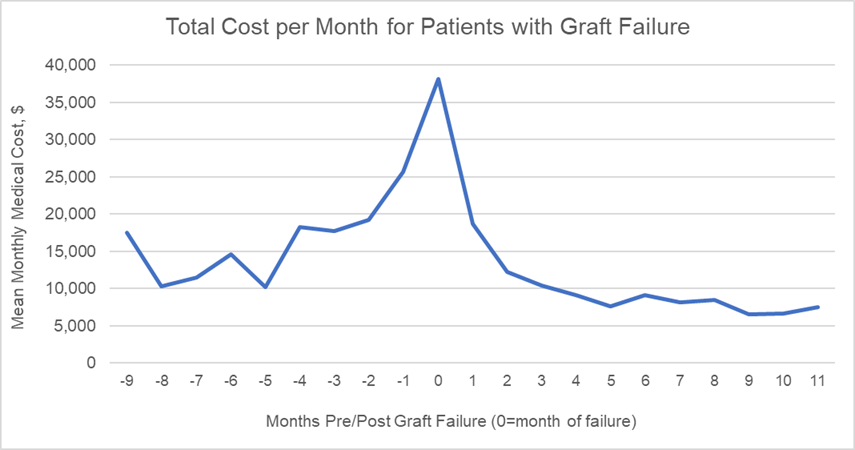Medical Costs in the Year Following Kidney Transplantation: Relationships with Renal Function and Graft Failure
1MedStar Georgetown Transplant Institute, Washington, DC, 2Saint Louis University, St. Louis, MO, 3Genesis Research, Hoboken, NJ, 4Angion Biomedica, San Francisco, CA
Meeting: 2021 American Transplant Congress
Abstract number: 716
Keywords: Economics, Graft failure, Graft function, Kidney transplantation
Topic: Clinical Science » Ethics » Non-Organ Specific: Economics & Ethics
Session Information
Session Name: Non-Organ Specific: Economics & Ethics
Session Type: Poster Abstract
Session Date & Time: None. Available on demand.
Location: Virtual
*Purpose: We describe relationships between total medical costs in the first year following kidney transplant with overall renal function as measured by: 1) estimated glomerular filtration rate (eGFR) at different time point during the first year, and; 2) early graft failure.
*Methods: The United States Renal Data System was used to identify adults receiving single-organ deceased donor kidney transplants 2012-2015. Recipients without Medicare as primary payer were excluded. Costs derived from Parts A and B claims including inpatient, emergency, outpatient, and skilled nursing facility costs. eGFRs were available at discharge, 6-months, and 12 months. Thus, eGFR:Cost relationships are described for several month-based time periods post-discharge: 0-3, 3-6, 6-12, and 3-12. For recipients with graft failure a time-history of medical costs was constructed with failure as the index date. Descriptive analyses were conducted.
*Results: For those without graft failure in the first year, total medical costs exhibit strong trends with eGFR in the post-discharge period. In the 3-6 months post-discharge, recipients with 6-month eGFRs of 30-59 mL/min/1.73m2 have total costs 48% lower than those with <30 mL/min/1.73m2. Both 6- and 12-month eGFRs correlate well with costs from 3 to 12 months post-discharge. Recipients with graft failure in the first year, monthly costs begin to rise 3-4 months prior to failure, with a spike of over $38,000 during the month of failure. Costs appear to stabilize 2-3 months post failure suggesting a months-long failure process.
*Conclusions: Total medical costs in the first year post-transplant are strongly correlated with eGFR at various times post-discharge. Time histories of resource utilization indicate that graft failure in the first year is a very expensive process unfolding over several months.
To cite this abstract in AMA style:
Cooper M, Schnitzler MA, Nilubol C, Wang W, Zhu X, Wu J, Nordyke RJ. Medical Costs in the Year Following Kidney Transplantation: Relationships with Renal Function and Graft Failure [abstract]. Am J Transplant. 2021; 21 (suppl 3). https://atcmeetingabstracts.com/abstract/medical-costs-in-the-year-following-kidney-transplantation-relationships-with-renal-function-and-graft-failure/. Accessed January 6, 2026.« Back to 2021 American Transplant Congress


